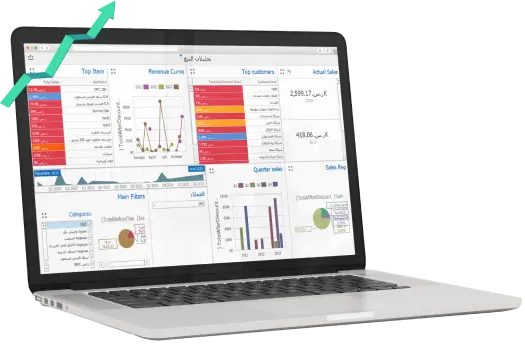The Importance of the Income Statement
The income statement has a set of objectives, including that it presents the financial results of a business over the fiscal period and determines reasons for the increase or decrease the profits and losses by analyzing the company's main business in terms of sales, cost of goods sold, operating expenses, and accidental revenues, also, all lines items of the current period are compared through the income statement for judgment the company's performance and income, whether it is increasing or decreasing and knowing the reasons for the company takes action in the subsequent periods, sometimes the company may achieved a profit but its main business is losing due to the increase in the rest of the expense line items, and it is possible that the company achieved large profits as a result of selling one of its fixed assets and its main business is losing, but the rentals of sales of assets is higher than the loss of the main business, net income will show a profit, but if we prepared the multiple-step income statement, the decision-maker will discover the operating activities has a large loss.
The Disadvantages of Income Statements
First, it is possible to show a high profit, but does not has sufficient liquidity or there is large gap between the profitability figure and the cash flows from operating activities figure
Therefore, the analysis of the income statement involves comparing the different line items with the previous year with profitability ratios and also knowing the reason of difference between the operating cash flow and net profit figure.
Types of Income Statements
There are two types of preparing the income statement that the accountants are familiar with:
Firstly, Single-Step Income Statement:
A single-step income statement presents a company's revenues, expenses, and income in a simple form:
Revenues: Whatever their source, whether revenues from a business's primary activities or secondary sources of revenues.
Expenses: Whatever their type, whether the cost of goods sold (COGS) or other expenses.
This statement is called the single-step income statement, which means that the expenses are collected according to their nature in the sense that the salaries are collected all in one item, the depreciation is the same and the transportation cost is all in one item and the other expenses are all collected by each type of expense that it collects with some or it is possible to collect such an expense in one item, this statement is used in very small companies and service offices and charities, and it is not used in large companies because it does not distribute or analyze the expense according to its function because each item differs in its nature and the company must analyze all the items of expenses into general and administrative expenses, marketing expenses, operating expenses
Secondly, Multi-Step Income Statement:
This is the common and used, the function of expense method and is also called the cost of sales method in the sense that the nature of the expense is seen as part of the cost of sales, no part of the general or selling expenses and the operating expenses are part of the cost of sales, and also the distinction between the revenue resulting from primary business activity and the revenue resulting from other activities is occasional or minor, the distinction between expenses for the main activity of the enterprise and the other incidental expenses resulting from certain financial policy conditions of the enterprise and the second is used in practical reality in the firms and financial institutions.
Effects of GAAP on the Income Statement
1- Accrual basis is that revenues and expenses are recognized for the current period regardless of whether it is collected, paid, or not collect and paid them.
2- Matching Principle: The income of each accounting period is allocated with the expenses that contributed to bringing the revenue and achieving it, the difference between revenues and expenses is the company profit.
The calculation of the cost of goods sold for a manufacturing company
Raw material, supplies, and spare parts opening inventory
(+) Purchases of raw material, supplies, spare parts, and packing
(-) Raw materials, supplies, spare parts, and packing closing inventory
(=) Direct Material used in Production
(+) Depreciation - Factory
(+) Salaries of Production Heads / Supervisors
(+) Manufacturing overhead
(+) Work-in-Process (WIP) Opening Inventory
(-) Work-in-Process (WIP) Ending Inventory
(=) Cost of goods manufactured
(+) Finished goods opening inventory
(-) Finished goods ending inventory
(=) Cost of goods sold
The calculation of the cost of goods sold for a merchandising company
The cost of sales in merchandising companies that do not have any manufacturing operations is based on the idea of calculating the cost of the product (the finished product), which is all the costs of purchasing and shipping that are allocated to the items until they enter the company's warehouses and upon issuing from the warehouse it is according to the method of inventory valuation and pricing technique, whether it First In, First Out (FIFO) or the weighted average method and Last In, First Out (LIFO) is canceled in the international and Egyptian standard for tax considerations because it is currently prevalent in the world that the prices of raw materials and goods are high, When the goods are issued from the warehouses, the recently receiving items are issued first, depending on this method, and therefore, the price of the items is higher than the old items, the cost of goods sold or issuing from warehouses is high, and therefore the profit will be low, and accordingly the taxes will be a low tax because the company’s profit is low compared to if it uses another method
First In, First Out (FIFO)
The material that is first purchased will be issued from warehouses and sell them first before recently purchased products
The advantage of this method is that when products are issued from warehouses, the products that were purchased first are issued, meaning that the cost of the ending inventory will be evaluated at the latest price available in the market
Consequently, the inventory appears in the balance sheet at a value comparable to its market value, and the disadvantage of this method is that the selling price is at the most recent price, while the cost of sales is applied at the oldest prices and therefore in the income statement is not homogeneous
Weighted Average Method
Its idea that the average price of each unit would be calculated after each a new purchase and therefore cost changes according to the item purchase price either up or down and now assuming that the purchase price of inventory or the raw materials are in the case of high, it is in this case, the better for the company to use the weighted-average method because this means that it follows a rise in the cost per unit and therefore the cost of sales increases and pays lower taxes, and this is in its interest, but if purchase prices are always down, it is best for the company to use First-in, first-out (FIFO), because the inventory issuance cost or the cost of sales will be high and consequently its profit reduces and pays taxes less
Production Cost vs. Cost of Goods Manufactured (COGM): What's the Difference?
Production Cost = Direct Material + Direct Labor + Manufacturing Overhead Costs
Cost of Goods Manufactured (COGM) = Beginning Work in Process (WIP) Inventory + (Direct Materials Used + Direct Labor Used + Manufacturing Overhead) - Ending Work in Process (WIP) Inventory
At the end of the fiscal period, actual overhead are recorded, and allocated manufacturing overhead are changed to equal for actual cost
Otherwise, we can say that the production cost be included when calculating the cost of goods manufactured
Non-Recurring Items & Extraordinary Items
Non-recurring items have a significant effect on the income statement because these items are which through you can manage your company, control the profit figure by classifying them in items that do not proportional to its nature, meaning that it be able to manipulate figures the shown profit by this item is described as a non-recurring item, the financial analyst, of course, should exclude these items when estimating the company's earning power and its ability to forecast future cash flows.
Non-Recurring Items
According to the international standard, non-recurring items divided into a group of items, but in the Egyptian standard the company does not present any income items, and expense as extraordinary items whether in the income statement, statement of comprehensive income, or notes to the financial statements
1- Unusual or infrequent items
They are the items that do not combine these two characteristics and these items are presented in the income statement separately after the financing interest without any excluding the tax value to get the net profit from the continuing operations and it must be presented separately because it has an unusual nature in the sense that it will be neither a primary component for the profit figure nor the cash flow figure
Such as gains, losses, disposal of fixed assets, investments in the subsidiary or affiliated companies, provisions, or impairment of assets, and at present these items have become essential in most income statements, especially provisions and impairment of assets, and some companies include them before the operating profit figure and some companies include them after the operating profit figure as per their vision
2- Discontinued Operations
In the event that the company decided to superseded or even sell one of the company’s business sectors, the operating profit from the discontinued operations and any gains or losses show after net profit after tax separately because these activities will not contribute to profits and future cash flows
There are 3 dates
Measurement Date: the date on which the company’s management decides to dispose of a segment of the business
Disposal Date: the date upon which the segment is disposed of through sale or abandonment
Phase-out Period: the period between Measurement Date and Disposal Date
3- Extraordinary Items
It is characterized by two fixed characteristics together and they are
It is of an unusual nature and this is when there is a transaction or any event characterized by a high degree of extraordinary and not related to the normal activities of the company and is associated with it incidentally
Not frequent occurrence in the sense that the recurrence of this event is not possible to a reasonable degree in the future and these items are presented after continuous operations and are net of taxes in the sense that they are after the net profit after tax figure and these items are such as losses resulting from the government seize some of the company's assets and losses resulting from natural disasters such as earthquakes and floods
Income Statement into Practical Reality
For the year ended 30th June 2012
2012 EGP | 2011 EGP | |
| Revenue | ـــــــــــــــــ | ـــــــــــــــــ |
| Sales | ـــــــــــــــــ | ـــــــــــــــــ |
| Cost of Goods Sold | ـــــــــــــــــ | ـــــــــــــــــ |
| Gross profit | ـــــــــــــــــ | ـــــــــــــــــ |
| Other Operating expenses | ـــــــــــــــــ | ـــــــــــــــــ |
| Marketing Expenses | ـــــــــــــــــ | ـــــــــــــــــ |
| Selling, general & administrative (SG&A) expenses | ـــــــــــــــــ | ـــــــــــــــــ |
| Salaries and remuneration of the board members | ـــــــــــــــــ | ـــــــــــــــــ |
| Other operating income | ـــــــــــــــــ | ـــــــــــــــــ |
| Operating profit (or loss) | ـــــــــــــــــ | ـــــــــــــــــ |
| Finance charges | ـــــــــــــــــ | ـــــــــــــــــ |
| Investments in subsidiaries | ـــــــــــــــــ | ـــــــــــــــــ |
| Held-to-maturity investments | ـــــــــــــــــ | ـــــــــــــــــ |
| Provisions no longer required | ـــــــــــــــــ | ـــــــــــــــــ |
| Impairment of investments in subsidiaries | ـــــــــــــــــ | ـــــــــــــــــ |
| Inventory write-down | ـــــــــــــــــ | ـــــــــــــــــ |
| Impairment of accounts receivables | ـــــــــــــــــ | ـــــــــــــــــ |
| Impairment of prepaid expense and other debit balances | ـــــــــــــــــ | ـــــــــــــــــ |
| Provisions | ـــــــــــــــــ | ـــــــــــــــــ |
| Interest income | ـــــــــــــــــ | ـــــــــــــــــ |
| Gain or loss on sale of assets | ـــــــــــــــــ | ـــــــــــــــــ |
| Currency valuation differences | ـــــــــــــــــ | ـــــــــــــــــ |
| Business interruption loss | ـــــــــــــــــ | ـــــــــــــــــ |
| Other expenses | ـــــــــــــــــ | ـــــــــــــــــ |
| Income (loss) before tax | ـــــــــــــــــ | ـــــــــــــــــ |
| Deferred income tax | ـــــــــــــــــ | ـــــــــــــــــ |
| Profit or loss for the period | ـــــــــــــــــ | ـــــــــــــــــ |
| Earnings per share | ـــــــــــــــــ | ـــــــــــــــــ |
| ـــــــــــــــــ | ـــــــــــــــــ |
Statement of Comprehensive Income
The main purpose of preparing the statement of comprehensive income is to the International Standards are currently tending to measuring the assets and liabilities at fair value at the reporting period and applying fair value leads to unrealized gains/losses and to prevent the gains include on the income statement (Profit and Loss Statement) and subject to taxes, therefore, the statement of comprehensive income is prepared and these items are also included in the statement of changes in equity, according to IAS 1 Presentation of Financial Statements, it is binding on enterprises in preparation of their financial statements in compliance with the latest amendments to the Egyptian standards at the end of 2015 has also been committed to its preparation, the companies under the international standard are entitled to present each statement separately or the two statements are presented as one statement, but according to the Egyptian standard, the company doesn’t entitle that but it must prepare two separate statements, income statement and statement of comprehensive income, according to paragraph 81 of the Egyptian standard, in other words, we can say that other components of the statement of comprehensive income are an account of equity accounts and a set of profits and losses that are not yet recognized in the income statement, and recorded temporarily in the equity to prove the comprehensive income and expected for the company because this is important to users of financial statements because it shows the expected profit and loss that about to achieve.
Income Statement vs. Statement of Comprehensive Income
Income statement, which relates to the income and costs of the company activity, starting from sales and ending with net profit, but and the statement of comprehensive income is different as it starts where the income statement completed, of course, in case it is shown separately and the statement of comprehensive income, these items are added to it and are
1- Exchange differences resulting from the translation of financial statements.
2- Gain or loss on an available-for-sale financial asset.
3- Profit or loss of insurance contracts.
4- Actuarial gain or loss arising on the defined benefit obligation.
Items of Statement of Comprehensive Income
1- Items that can be transferred to the income statement upon sale, such as unrealized gains and losses resulting from revaluation on investments available for sale.
2- Items that cannot be transferred to the income statement even if the sale is made, such as the revaluation surplus, but if the sale is made, they transferred in the equity from other statement of comprehensive income components to retained earnings.
Preparing the Statement of Comprehensive Income
First, we take the net income for the year and let say 750,000
We add on them some items such as
1- Foreign currency translation adjustment
The exchange difference is included in the income statement, whether debit or credit, but there is a type of exchange difference that is included in the statement of comprehensive income and also in the statement of changes in equity
This is in case, for example, there is a company in Egypt has a subsidiary in the USA and there is a cash amount due to be paid to the company in Egypt if payment were made, and there were exchange difference, they were included in the statement of comprehensive income and also the statement of changes in equity, and is not included in the income statement
2- Financial investments available for sale and these investments are evaluated at the end of the fiscal period, and when there are gains or losses upon evaluation, they are included in the statement of comprehensive income
Example of investments available for sale
Financial investments available for sale, for example, you purchased financial investments of $ 100,000 and at the end of the year, you found that the investments were priced at $ 120,000. There is a difference of $ 20,000 profit and it is considered unrealized because the sale has not been made (where according to international accounting standards, the investments are evaluated annually at market value) this $ 20,000 is included in the statement of changes in equity in the item of other comprehensive income components are named unrealized gains, and those profits are included in the income statement if the sale is made
3- Gains on revaluation of fixed assets, which of course are canceled in the Egyptian standard in the 2015 amendments, but they are still applied in the international standard
It is known that assets are valuation in one of two methods
1- Amortized Cost
2- Revaluation
Amortized cost, which is that the asset is recorded at its historical cost and the depreciation is created by common methods of depreciation, and at the end of the year performing an impairment test
Revaluation, the asset is recorded at its cost, and the end of the year its fair market value is evaluated how much (Market value - disposal and sales costs)
If there is a loss, meaning the fair value is less than the recorded book value, then these impairment losses are considered as an expense and are included in the income statement
The journal entry is as follows:
| Account | Debit | Credit |
| Impairment Loss of Asset Account | XXXXX | |
| Asset Account | XXXXX |
OK, if the fair value were greater than the book value
There is a revaluation surplus and this is included in the statement of changes in equity and other comprehensive income components









